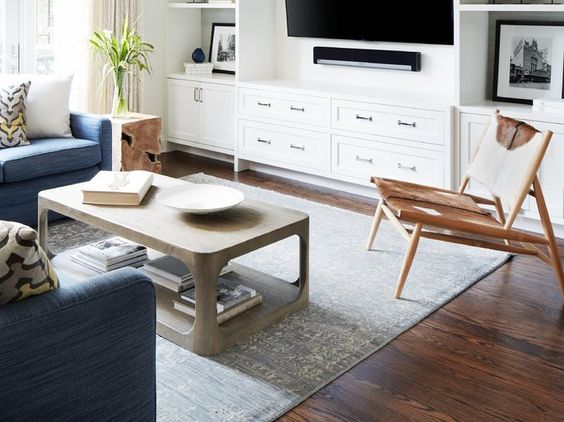Ready to buy a new rug, but aren’t sure what the best size for your space is? These these room-by-room essentials and foolproof tips are here to help—so when it comes time to unroll the rug, you know it’ll fit exactly the way you want.
Sizing Tips for All Spaces
Bigger is Better
A few inches makes all the difference between the rug pulling the room together or chopping it up. Opting for the larger option, especially if you’re between sizes, will prove worth the extra expense every time.
Take Cues From Your Room
Both for the rug size and its orientation. The rug should be proportional to the space (large rooms = large rugs) and placed to echo its dimensions (long room = orient lengthwise).
Visualize the Final Look
By using painter’s tape to mock the rug placement before you buy. This trade secret is an easy way to check that you have the right fit from every vantage point.
Rug Sizing by Room
To find the right rug size, consider both the size of your space and the furniture grouping—measuring each as a first step. Then choose a rug layout from the common options below.
Living Room
Your room shape, not just the furniture, should dictate the rug size and orientation to make the space look larger and feel connected. If you choose a layout with the sofa on the rug, it should extend at least 6 inches on each side for proper scale.
All Legs on the Rug

Front Legs on the Rug

This versatile option works especially well when one edge of the furniture grouping is against a wall. (You don’t need to pay for a rug to cover a spot no one sees!) Consistency is key for a cohesive look, so the rug should be sized to allow for front-legs only across all pieces.
Coffee Table on the Rug

Perfect for small or narrow spaces, this layout plays off the room’s scale to make it feel larger. To get the proportion right, base the rug size on the interior dimensions of your seating area—and not just the coffee table—so it fills the negative space created by your furniture grouping.
Dining Room
Both the shape of your room and dining table should make the rug choice clear—whether it’s rectangular or round.
All Legs on the Rug


Our only advice? Stick with all legs on the rug for this room—for safety’s sake. It should extend 36 inches beyond all sides of the table (no less than 24), so chairs can sit on a flat surface, even when pushed back. Don’t forget to account for extendable leaves, if your table has them.
Bedroom
As the focal point of the room, your bed should also be the base for rug placement. Not only will this further define space, but will also give your feet a soft spot to land each morning.
All Legs on the Rug

This all-inclusive layout extends beyond the bed to its accompanying furniture, like nightstands or a bench—but does not include bedroom pieces along other walls, like dressers. Rule of thumb is to leave around 18-24 inches of space, but not encroach upon any main walkways.
2/3 Bed on the Rug

Frame your bed with this popular option, which doesn’t quiet extend up to your nightstands but still allows for 18-24 inches of room on the sides and past the foot of the bed. For a symmetrical finish, an 8×10 rug is best for queen beds and a 9×12 for king.
Runners on Each Side

This flexible choice works for spaces and beds of all sizes—and is a great option if two sides of the bed sit against a wall. Scale matters for this look: The runner shouldn’t extend beyond the bed itself, but should be a bit wider than your nightstand.
Kitchen
A well-placed runner can visually extend the space, whether you have a galley kitchen or large island. For U-shaped layouts, a small rug in front of the sink centers the space nicely.
Hallway
Runners are the go-to choice for corridors. It’s best not to clutter these narrow thoroughfares, so leave all furniture legs off the rug in this space.
Entry
Let the shape of the space dictate the choice of round, rectangular, or runner, and use the width of your front door as a baseline. Check the pile height to ensure your door will clear the rug when it’s opened.












